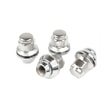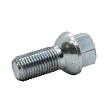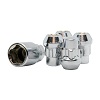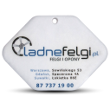Regulation R117-04 – tires and driving safety with minimal tread
Previous regulations allowed for varying interpretations regarding the timing of tire replacement, leading to the premature disposal of even technically sound tires. Regulation R117-04, developed by the United Nations Economic Commission for Europe, introduces the requirement to maintain declared traction parameters even when the minimum tire tread depth reaches 1.6 mm.
The introduction of Regulation R117-04 is an attempt to reduce the number of prematurely disposed tires and improve resource efficiency. According to the European Commission, extending tire life will reduce CO₂ emissions by over 6.5 million tons per year and generate savings of up to €7 billion across the European Union.
From the perspective of the vehicle user, conscious monitoring of minimum tire tread and the ability to assess the actual safety level of tires in the final phase of their life are particularly important. The following section will discuss the key assumptions of the regulation, its impact on the market, and methods for measuring and interpreting tread wear. We will also present manufacturers' positions, the potential consequences of driving with substandard tires, and the impact of the new regulations on the environment and operating costs.
Contents:
- What is Regulation R117-04? A key tire safety regulation.
- Why is tread depth crucial for road safety?
- How to measure tire tread and how often should you do it?
- Is it worth waiting until the minimum tread depth is reached before replacing tires?
- Signs of a worn tire – what else should you look for besides the tread?
- FAQ – additional questions and answers about the R117-04 regulation
- Does the R117-04 regulation affect tire prices?
- Since when and in which countries has regulation R117-04 been in force?
- Does Regulation R117-04 also apply to tires sold as used?
- How to check if a tire meets the R117-04 standard?
- What are the consequences of driving on tires that do not meet the R117-04 standard?
- Do the changes resulting from R117-04 impact the environment?
What is Regulation R117-04? A key tire safety regulation.
The newly introduced UNECE R117-04 regulation mandates tire testing not only in its factory condition but also after wear, down to a minimum tread depth of 1.6 mm. According to the requirements, tires must retain at least 80% of their braking performance compared to a factory-fresh model tested on wet surfaces at 80 km/h. The new tire regulations require the use of more durable rubber compounds and optimized tread patterns, ensuring safe performance even at the end of the tire's life. To obtain homologation, the manufacturer must confirm the durability of traction properties even after wear.
Users experience a higher level of safety, but also the need to monitor wear—even the best tires cease to meet requirements once the allowable tread wear limit is exceeded. Regulation R117-04 also increases market transparency and changes the way tires are evaluated, rewarding models with long-term performance.

Why is tread depth crucial for road safety?
Tire condition determines braking effectiveness, steering precision, and water evacuation. The more worn the tire tread, the higher the risk of skidding, especially on wet surfaces. Even a few millimeters less tread significantly reduces aquaplaning resistance, and braking distances can increase by several meters. The minimum tire tread depth of 1.6 mm represents the limit of technical usability, not the recommended performance value.
By choosing models covered by the R117-04 regulation, drivers receive confirmation that the tire maintains traction even at the wear limit. This design ensures safety both at the beginning of use and at the end of the tire's life. The minimum tread depth on tires is not just a number prescribed by law—it represents a safety limit.
How to measure tire tread and how often should you do it?
A reliable tool is a specialized depth gauge, which is placed against the center of the tread, pressing the gauge down to the base of the groove. How do you measure tire tread with such a device? Measurements should be taken at several points around the circumference to detect any uneven wear. If access to the tool is limited, a coin can be used (e.g., a 5 złoty coin – with the rim visible, this indicates approaching the wear limit). The minimum legal tread depth is 1.6 mm – although experts recommend replacing tires earlier, at around 3 mm for summer tires and when the minimum tread depth for winter tires drops below 4 mm. Worn tire tread reduces traction and significantly increases braking distances.

Is it worth waiting until the minimum tread depth is reached before replacing tires?
No, it's not worth waiting until your tire's minimum tread depth reaches the 1.6 mm limit – because traction drops significantly earlier and the risk of aquaplaning increases. The legal minimum tread depth is 1.6 mm – but in practice, it's better to act early.
Signs of a worn tire – what else should you look for besides the tread?
Worn tire tread is just one sign that tires are nearing the end of their service life. In practice, other signs of deterioration are also important and can impact driving safety – even if the minimum tread depth hasn't been exceeded. Here are the three most common signs to watch out for:
- Cracks and delamination on the sides of the tire indicate rubber degradation and the risk of cracking while driving.
- Uneven tread wear – may indicate problems with suspension geometry, pressure or shock absorption.
- Noise or vibration at higher speeds – often due to improper balance or internal structural damage.
| Tire wear symptom | Possible cause | Potential security implications |
|---|---|---|
| Cracks and delamination of the sides | Rubber aging, weather conditions | Risk of tire burst while driving |
| Uneven tread wear | Problems with geometry, pressure, and shock absorption | Deterioration of handling, uneven braking |
| Noise and vibration at higher speeds | Unbalance, internal damage | Reduced ride comfort, increased suspension wear |
| Tread depth less than 3-4 mm | Natural wear and tear | Increased braking distance, risk of aquaplaning |
| The rim of a 5 PLN coin is visible in the tread groove. | Close up to the tread limit (1.6 mm) | Urgent need to replace tires |
FAQ – additional questions and answers about the R117-04 regulation
To better understand the topic, we've prepared a set of frequently asked questions about the introduction of the R117-04 regulation and its impact on everyday use and tire selection. The answers below provide practical explanations related to the regulations, costs, and safety of driving with minimal tire tread.
Does the R117-04 regulation affect tire prices?
Yes, the R117-04 regulation may increase tire production costs. This translates into slightly higher prices for models that meet the standard.
Since when and in which countries has regulation R117-04 been in force?
Regulation R117-04 entered into force in the European Union in July 2024, covering all member states and countries applying UNECE regulations. The regulations apply to tires approved after this date and affect both manufacturers and importers, who must ensure that their tires comply with the new requirements, including those regarding traction with minimal tread.
Does Regulation R117-04 also apply to tires sold as used?
No, the tire regulations only apply to new models approved for sale. Used tires do not have to meet the wear test requirements.
How to check if a tire meets the R117-04 standard?
Information on compliance with the standard can be found in the homologation documentation or on the product label. In modern cars, it's worth using a TPMS system, which can help detect irregularities resulting from tire wear.
What are the consequences of driving on tires that do not meet the R117-04 standard?
In the case of new tires, lack of homologation means a ban on sale in the EU market. For drivers, this means potential fines and insurance complications in the event of an accident.
Do the changes resulting from R117-04 impact the environment?
Yes, new tires are designed to be more durable and efficient, so (theoretically) they will reduce waste. A longer service life also reduces CO₂ emissions associated with production.




 Modern design
Modern design Perfect fit
Perfect fit High durability
High durability Free shipping within 24 hours
Free shipping within 24 hours
 Individual project
Individual project Dedicated caregiver
Dedicated caregiver













